
Puerto Ayora: Gateway to the Enchanted Galápagos Islands
Discover Puerto Ayora, the bustling gateway to Ecuador's Galápagos Islands, where adventure, wildlife, and vibrant culture await every traveler.
Puerto Ayora, located on Santa Cruz Island in Ecuador, is the vibrant heart of the Galápagos archipelago. This charming town is the largest on the islands and serves as a bustling hub for tourists and researchers alike. The main street, Avenida Charles Darwin, is lined with restaurants, shops, and tour operators, making it the perfect place to plan your Galápagos adventures. The town is home to the Charles Darwin Research Station, a must-visit for anyone interested in the conservation efforts that protect the unique wildlife of the Galápagos. Here, you can learn about the giant tortoise breeding programs and see these magnificent creatures up close. Nature lovers will delight in the nearby Tortuga Bay, a pristine white-sand beach where you can spot marine iguanas, colorful Sally Lightfoot crabs, and even snorkel with sea turtles. For a more immersive experience, take a water taxi to Las Grietas, a stunning natural swimming hole nestled between volcanic rock formations. Puerto Ayora is not just about nature; it also offers cultural experiences. The local fish market is a lively spot where you can watch fishermen bring in their daily catch, often accompanied by curious pelicans and sea lions. For a taste of local cuisine, try the fresh seafood at one of the many seaside restaurants. With its mix of natural beauty, wildlife encounters, and cultural experiences, Puerto Ayora is the perfect starting point for exploring the wonders of the Galápagos Islands.
Local tips in Puerto Ayora
- Visit the Charles Darwin Research Station early in the morning to avoid crowds.
- Carry cash as many smaller shops and eateries do not accept credit cards.
- Book tours and excursions in advance, especially during peak tourist seasons.
- Don't miss the fish market at the pier for a unique local experience.
- Use eco-friendly products to help preserve the delicate ecosystem of the islands.
Puerto Ayora: Gateway to the Enchanted Galápagos Islands
Puerto Ayora, located on Santa Cruz Island in Ecuador, is the vibrant heart of the Galápagos archipelago. This charming town is the largest on the islands and serves as a bustling hub for tourists and researchers alike. The main street, Avenida Charles Darwin, is lined with restaurants, shops, and tour operators, making it the perfect place to plan your Galápagos adventures. The town is home to the Charles Darwin Research Station, a must-visit for anyone interested in the conservation efforts that protect the unique wildlife of the Galápagos. Here, you can learn about the giant tortoise breeding programs and see these magnificent creatures up close. Nature lovers will delight in the nearby Tortuga Bay, a pristine white-sand beach where you can spot marine iguanas, colorful Sally Lightfoot crabs, and even snorkel with sea turtles. For a more immersive experience, take a water taxi to Las Grietas, a stunning natural swimming hole nestled between volcanic rock formations. Puerto Ayora is not just about nature; it also offers cultural experiences. The local fish market is a lively spot where you can watch fishermen bring in their daily catch, often accompanied by curious pelicans and sea lions. For a taste of local cuisine, try the fresh seafood at one of the many seaside restaurants. With its mix of natural beauty, wildlife encounters, and cultural experiences, Puerto Ayora is the perfect starting point for exploring the wonders of the Galápagos Islands.
When is the best time to go to Puerto Ayora?
Iconic landmarks you can’t miss
Galapagos Up las Grietas
Explore the breathtaking natural beauty of Galapagos Up las Grietas, where stunning rock formations meet crystal-clear waters in Puerto Ayora.

Tortuga Bay Beach
Explore Tortuga Bay Beach in the Galápagos Islands, a stunning natural paradise featuring white sands, turquoise waters, and diverse wildlife.

Santa Cruz Brewery
Experience the rich flavors of local craft beer at Santa Cruz Brewery, a must-visit brewpub in Puerto Ayora, Galapagos Islands.
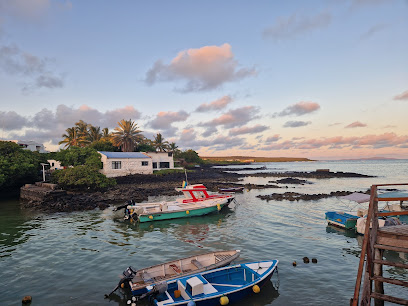
Galapagos Deli
Discover the vibrant culinary scene of Puerto Ayora at Galapagos Deli, where delicious pizzas and local delicacies await every traveler.

The Rock Galapagos
Experience the vibrant flavors of Asian cuisine at The Rock Galapagos, a must-visit restaurant in Puerto Ayora, Ecuador, amidst breathtaking natural beauty.

Charles Darwin Research Station
Explore conservation efforts at the Charles Darwin Research Station in Puerto Ayora, a hub for wildlife preservation and ecological education in the Galápagos Islands.

Restaurante El Descanso del Guía - Muelle
Savor the authentic tastes of Ecuador at Restaurante El Descanso del Guía in Puerto Ayora, a culinary gem in the heart of the Galapagos Islands.

El Muelle de Darwin
Experience the best of Ecuadorian cuisine at El Muelle de Darwin, nestled in the heart of Puerto Ayora, with fresh seafood and breathtaking views.

Midori
Discover Midori, Puerto Ayora's top sushi restaurant, offering fresh, innovative dishes that blend Japanese tradition with local flavors in a vibrant atmosphere.

Hotel Solymar Galapagos
Experience the beauty of the Galapagos Islands at Hotel Solymar, your perfect retreat in Puerto Ayora with modern comforts and easy access to wildlife adventures.

Almar
Discover the culinary delights of Almar in Puerto Ayora, where fresh seafood meets stunning ocean views in the heart of the Galápagos.

La Regata
Experience the best of Ecuadorian cuisine in Puerto Ayora at La Regata, where fresh ingredients meet stunning views for an unforgettable dining experience.

Golden Prague Pub
Experience the culinary charm of Golden Prague Pub in Puerto Ayora, where local flavors meet international cuisine in a vibrant atmosphere.

Bahía Mar
Experience the authentic flavors of Ecuador at Bahía Mar, a seafood paradise nestled in the heart of Puerto Ayora.

FRAFRE GASTROBAR
Discover Frafre Gastrobar in Puerto Ayora, where fresh local ingredients and innovative cuisine create an unforgettable dining experience in the Galápagos Islands.

Unmissable attractions to see
Rancho Primicias - Giant Tortoise Reserve
Explore Rancho Primicias, the enchanting Giant Tortoise Reserve on Isla Santa Cruz, where nature and conservation come together in the stunning Galápagos Islands.

Tortuga Bay Beach
Experience the pristine beauty and vibrant wildlife of Tortuga Bay Beach in the stunning Galapagos Islands, a must-visit paradise for all tourists.

Charles Darwin Research Station
Discover the Charles Darwin Research Station: a pivotal site for conservation and education in the stunning Galápagos Islands, perfect for every eco-conscious traveler.

Galapaguera de Cerro Colorado
Explore the Galapaguera de Cerro Colorado, a pristine nature preserve dedicated to the conservation of the iconic Galápagos tortoise on Isla San Cristóbal.
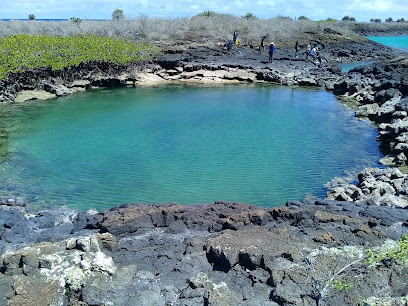
Galápagos Islands
Explore the Galápagos Islands, a UNESCO World Heritage site teeming with unique wildlife, stunning landscapes, and unparalleled eco-adventures.

Playa El Garrapatero
Experience the tranquil charm of Playa El Garrapatero, a hidden gem on Ecuador's stunning coastline, perfect for relaxation and nature exploration.

Santa Cruz Island
Explore the stunning Santa Cruz Island in the Galapagos - a paradise rich in wildlife, breathtaking landscapes, and unforgettable adventures.

Nymphs Lagoon
Explore the breathtaking beauty of Nymphs Lagoon in Puerto Ayora, a serene oasis teeming with unique wildlife and stunning landscapes in the Galápagos Islands.

El Chato Ranch - Giant Tortoise Reserve
Discover the enchanting El Chato Ranch in the Galápagos, where giant tortoises roam free amidst lush landscapes and rich biodiversity.

Playa los alemanes
Explore the enchanting Playa Los Alemanes in Puerto Ayora, a serene beach paradise with crystal-clear waters and vibrant marine life, perfect for relaxation and adventure.

Pit Craters
Explore the stunning Pit Craters of the Galapagos, a geological wonder filled with unique ecosystems and breathtaking landscapes.

North Seymour Island
Explore the stunning North Seymour Island in the Galápagos, where unique wildlife and breathtaking landscapes await every nature lover.

Parque Nacional Galapagos
Discover the unique ecosystems and incredible wildlife of Parque Nacional Galapagos, a UNESCO World Heritage site that offers adventure and natural beauty.

Playa Las Bachas
Experience the untouched beauty of Playa Las Bachas on Isla Santa Cruz, a serene beach perfect for relaxation and marine exploration.

Playa de la Estacion
Experience the breathtaking beauty and vibrant marine life of Playa de la Estacion in Puerto Ayora, a must-visit beach destination in the Galapagos Islands.

Essential places to dine
PLAZA EL JARDÍN GALÁPAGOS
Experience the vibrant flavors of Ecuador at Plaza El Jardín Galápagos - a culinary gem in Puerto Ayora with fresh local ingredients.

Restaurante El Descanso del Guía - Muelle
Experience authentic Ecuadorian cuisine at Restaurante El Descanso del Guía in Puerto Ayora - a culinary gem where flavor meets tradition.
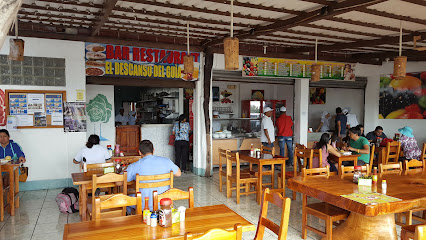
Isla Grill
Discover Isla Grill: A premier dining experience in Puerto Ayora serving exquisite grilled dishes and fresh seafood amidst Galápagos charm.

El Muelle de Darwin
Experience authentic Ecuadorian cuisine at El Muelle de Darwin in Puerto Ayora—where local flavors meet stunning ocean views.

Midori
Experience exquisite sushi at Midori in Puerto Ayora - where local flavors meet Japanese culinary artistry.

Lemon & Coffee
Discover delicious local flavors at Lemon & Coffee in Puerto Ayora - where every meal is a taste of paradise.

Almar
Discover Almar: A culinary treasure in Puerto Ayora offering fresh seafood and local delicacies amidst stunning Galápagos views.

La Regata
Discover authentic Ecuadorian cuisine at La Regata in Puerto Ayora, where tradition meets taste amidst stunning Galapagos scenery.
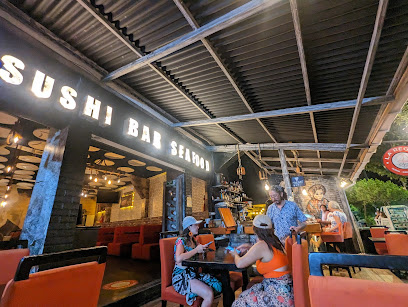
Bahía Mar
Experience exquisite Ecuadorian seafood at Bahía Mar in Puerto Ayora – where every meal is a celebration of local flavors and breathtaking ocean views.

Lo & Lo
Discover authentic Ecuadorian flavors at Lo & Lo, where every dish is crafted with love and local ingredients in beautiful Puerto Ayora.

FRAFRE GASTROBAR
Discover Frafre Gastrobar in Puerto Ayora: where local flavors meet modern culinary artistry amidst stunning island scenery.

Laguna Beach
Experience breathtaking beaches and vibrant culture at Laguna Beach in Puerto Ayora - a true gem of the Galapagos Islands.

TJ
Discover the vibrant flavors of Puerto Ayora at TJ - where culinary excellence meets tropical charm.

La Cevicheria by Isla Grill
Experience the best seafood dining in Puerto Ayora at La Cevicheria by Isla Grill—where freshness meets flavor in every bite.

The Union Restaurant
Experience authentic Ecuadorian cuisine at The Union Restaurant in Puerto Ayora – where every dish tells a story.

Markets, malls and hidden boutiques
Galapagos Deli
Experience the flavors of the Galapagos at Galapagos Deli, where fresh ingredients meet local culinary traditions in a cozy atmosphere.

1835 Restaurant & Coffee
Discover the flavors of the Galápagos at 1835 Restaurant & Coffee, where fresh ingredients meet delightful culinary creations.

Proinsular Market
Experience the vibrant local culture at Proinsular Market, a bustling supermarket in Puerto Ayora offering fresh produce, local delicacies, and unique souvenirs.

City Market
Discover the vibrant City Market in Puerto Ayora, where local culture, fresh produce, and unique crafts come together in a lively atmosphere.

Puerto Ayora
Explore Puerto Ayora: A vibrant gateway to the Galapagos Islands, rich in wildlife, culture, and unforgettable experiences.

DARWIN+WOLF
Discover unique fashion pieces at DARWIN+WOLF, where vibrant styles and quality craftsmanship meet in Puerto Ayora's premier clothing store.

Ferreteria Bodega Blanca S. A.
Explore the best of hardware and marine supplies at Ferreteria Bodega Blanca S. A. in Puerto Ayora, your gateway to Galápagos adventures.

Art Coffee Galápagos
Discover Art Coffee Galápagos, where exquisite local coffee meets the vibrant culture of Puerto Ayora in the breathtaking Galápagos Islands.

Chocolápagos
Discover the exquisite flavors of artisanal chocolates at Chocolápagos, a sweet gem in Puerto Ayora that celebrates the essence of the Galápagos Islands.

TiOS store at the waterfall
Discover the TiOS Store at the Waterfall - your gateway to local flavors and essentials in beautiful Puerto Ayora.
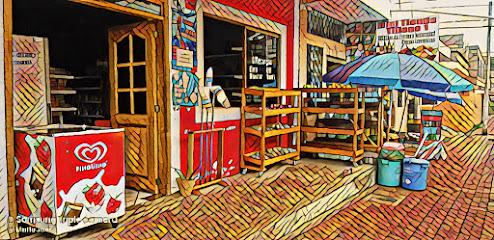
Élite Su Almacén
Explore Élite Su Almacén in Puerto Ayora for a delightful blend of appliances and local treasures in the heart of the Galápagos Islands.

Aymara Art & Jewelry
Explore the vibrant handmade crafts at Aymara Art & Jewelry in Puerto Ayora, showcasing authentic Galapagos artistry and craftsmanship.
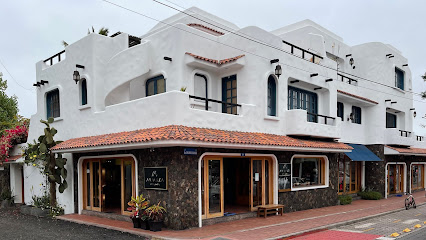
Santeria Tattoo Shop Galapagos
Discover unique body art at Santeria Tattoo Shop in Puerto Ayora, where creativity meets the breathtaking beauty of the Galapagos.

Galamaxy El Gato
Discover the vibrant offerings of Galamaxy El Gato, your go-to grocery store in Puerto Ayora for local and international culinary delights.

Galería Exótico Ecuador - Fair Trade
Explore Galería Exótico Ecuador for unique handcrafted art pieces that promote fair trade and celebrate Ecuador's rich cultural heritage.

Essential bars & hidden hideouts
The Rock Galapagos
Experience the exquisite flavors of Asian cuisine in the heart of Puerto Ayora, Galapagos Islands.

1835 Restaurant & Coffee
Discover the culinary delights of 1835 Restaurant & Coffee in Puerto Ayora, where fresh seafood, vegan options, and island coffee await.

Isla Grill
Discover Isla Grill in Puerto Ayora, where grilling meets the stunning flavors of the Galapagos Islands in a delightful dining experience.

El Muelle de Darwin
Experience the authentic taste of Ecuadorian cuisine at El Muelle de Darwin, a top dining destination in Puerto Ayora, Galapagos Islands.

Lemon & Coffee
Experience the vibrant flavors of Ecuador at Lemon & Coffee, a lively restaurant in Puerto Ayora with delightful dishes and live entertainment.

bongo bar
Experience the vibrant nightlife at Bongo Bar in Puerto Ayora, where refreshing cocktails and lively music bring the Galapagos spirit to life.

Golden Prague Pub
Experience the heart of Puerto Ayora at Golden Prague Pub, where local flavors meet international cuisine in a vibrant setting.

Lo & Lo
Discover the authentic taste of Ecuadorian cuisine at Lo & Lo in Puerto Ayora, where every dish tells a flavorful story.

Gelato Bar
Experience the delightful flavors of Gelato Bar in Puerto Ayora, where creamy gelato and rich espresso await amidst the beauty of the Galápagos Islands.

TJ
Discover the vibrant bar and restaurant TJ in Puerto Ayora, offering delicious local cuisine and exceptional espresso in a lively atmosphere.

Rincón del Alma
Discover Rincón del Alma in Puerto Ayora, where delicious grilled cuisine meets the vibrant culture of the Galápagos Islands.

Bowl Acai Bar
Discover Bowl Acai Bar in Puerto Ayora: Your go-to spot for vibrant acai bowls and healthful delights in the heart of the Galapagos.

La discoteca de Wilfrido
Dive into the vibrant nightlife at La discoteca de Wilfrido, Puerto Ayora's premier karaoke bar, where unforgettable memories await every night.

La Pausa
Discover La Pausa, a seafood paradise in Puerto Ayora, where fresh flavors meet vibrant island culture for an unforgettable dining experience.

The Point
Discover exceptional local cuisine and breathtaking views at The Point, a top-rated restaurant in Puerto Ayora, Galapagos Islands.

Local Phrases
-
- HelloHola
[Oh-la] - GoodbyeAdiós
[Ah-dee-ohs] - YesSí
[See] - NoNo
[Noh] - Please/You're welcomePor favor/De nada
[Por fa-vor/Deh nah-dah] - Thank youGracias
[Gra-see-as] - Excuse me/SorryPerdón/Lo siento
[Pair-dohn/Loh see-en-toh] - How are you?¿Cómo estás?
[Koh-moh ehs-tahs] - Fine. And you?Bien. ¿Y tú?
[Bee-en. Ee too] - Do you speak English?¿Hablas inglés?
[Ah-blahs een-glehs] - I don't understandNo entiendo
[Noh ehn-tee-ehn-doh]
- HelloHola
-
- I'd like to see the menu, pleaseQuisiera ver el menú, por favor
[Kee-see-eh-rah ver ehl meh-noo, por fa-vor] - I don't eat meatNo como carne
[Noh koh-moh kahr-neh] - Cheers!¡Salud!
[Sah-lood] - I would like to pay, pleaseMe gustaría pagar, por favor
[Meh goo-stah-ree-ah pah-gar, por fa-vor]
- I'd like to see the menu, pleaseQuisiera ver el menú, por favor
-
- Help!¡Ayuda!
[Ah-yoo-dah] - Go away!¡Vete!
[Veh-teh] - Call the Police!¡Llama a la policía!
[Yah-mah ah lah poh-lee-see-ah] - Call a doctor!¡Llama a un médico!
[Yah-mah ah oon meh-dee-koh] - I'm lostEstoy perdido
[Ehs-toy pair-dee-doh] - I'm illEstoy enfermo
[Ehs-toy ehn-fehr-moh]
- Help!¡Ayuda!
-
- I'd like to buy...Quisiera comprar...
[Kee-see-eh-rah kohm-prahr...] - I'm just lookingSolo estoy mirando
[So-loh ehs-toy mee-rahn-doh] - How much is it?¿Cuánto cuesta?
[Kwan-toh kwehs-tah] - That's too expensiveEso es demasiado caro
[Eh-soh ehs deh-mah-see-ah-doh kah-roh] - Can you lower the price?¿Puedes bajar el precio?
[Pweh-des ba-har ehl pree-syoh]
- I'd like to buy...Quisiera comprar...
-
- What time is it?¿Qué hora es?
[Keh oh-rah es] - It's one o'clockEs la una
[Ehs lah oo-nah] - Half past (10)Media hora (10)
[Meh-dee-ah oh-rah (dies)] - MorningMañana
[Mah-nyah-nah] - AfternoonTarde
[Tahr-deh] - EveningNoche
[Noh-cheh] - YesterdayAyer
[Ah-yehr] - TodayHoy
[Oy] - TomorrowMañana
[Mah-nyah-nah] - 1Uno
[Oo-no] - 2Dos
[Dohs] - 3Tres
[Tres] - 4Cuatro
[Kwah-troh] - 5Cinco
[Seen-koh] - 6Seis
[Sehs] - 7Siete
[Syeh-teh] - 8Ocho
[Oh-cho] - 9Nueve
[Nweh-veh] - 10Diez
[Dyehs]
- What time is it?¿Qué hora es?
-
- Where's a/the...?¿Dónde está...?
[Dohn-deh ehs-tah] - What's the address?¿Cuál es la dirección?
[Kwahl ehs lah dee-rehk-syohn] - Can you show me (on the map)?¿Puedes mostrarme (en el mapa)?
[Pweh-des mohs-trar-meh (ehn ehl mah-pah)] - When's the next (bus)?¿Cuándo es el próximo (autobús)?
[Kwan-doh ehs ehl proh-ksy-moh (ow-toh-boos)] - A ticket (to ....)Un boleto (a ....)
[Oon boh-leh-toh (ah)]
- Where's a/the...?¿Dónde está...?
History of Puerto Ayora
-
Puerto Ayora, located on the southern shore of Santa Cruz Island in the Galápagos archipelago, was established in the early 20th century. The town was named after Isidro Ayora, an influential Ecuadorian politician and former president of Ecuador.
-
In 1959, the Charles Darwin Foundation was established, and by 1964, the Charles Darwin Research Station was inaugurated in Puerto Ayora. This institution plays a crucial role in scientific research and conservation efforts in the Galápagos Islands, attracting scientists from around the globe to study its unique biodiversity.
-
The 1970s marked the beginning of a significant tourism boom in Puerto Ayora. With the establishment of the Galápagos National Park and the construction of the Baltra airport, the town became a central hub for visitors exploring the natural wonders of the Galápagos Islands. This period saw rapid growth in infrastructure, including hotels, restaurants, and tour services.
-
Throughout the late 20th and early 21st centuries, Puerto Ayora has been at the forefront of conservation efforts in the Galápagos. Initiatives to protect endangered species, control invasive species, and promote sustainable tourism have been integral to preserving the islands' unique ecosystem. However, the town has also faced challenges such as managing the impact of increasing tourist numbers and addressing environmental threats.
-
Puerto Ayora is not only known for its natural beauty but also for its vibrant local culture. The town hosts various cultural festivals throughout the year, including the Fiesta de Santa Cruz, which features traditional music, dance, and local cuisine. These events provide a glimpse into the rich cultural heritage of the Galápagos and the daily lives of its residents.
Puerto Ayora Essentials
-
Puerto Ayora is located on Santa Cruz Island in the Galápagos Archipelago. To get there, you need to fly into either Seymour Airport (GPS) on Baltra Island or San Cristóbal Airport (SCY) on San Cristóbal Island. From Seymour Airport, a short bus ride, ferry, and taxi will get you to Puerto Ayora. The total travel time from Seymour Airport to Puerto Ayora is typically around 1.5 to 2 hours. If arriving at San Cristóbal Airport, you can take a speedboat to Santa Cruz Island, which takes approximately 2 hours.
-
Puerto Ayora is a small town, and many of its attractions are within walking distance. For longer trips, taxis are readily available and relatively inexpensive. Water taxis are also an option for getting around the harbor area. If you wish to explore more of Santa Cruz Island, renting a bike or hiring a private car with a driver can be convenient. Public buses connect Puerto Ayora with other parts of the island, including the highlands and the Itabaca Channel.
-
The official currency in Ecuador is the US Dollar (USD). Credit cards are accepted in most hotels, restaurants, and shops in Puerto Ayora, but it is advisable to carry cash for smaller establishments and markets. ATMs are available in the town where you can withdraw cash. Be mindful that some ATMs may have withdrawal limits, so plan accordingly.
-
Puerto Ayora is generally a safe destination for tourists. However, it is always recommended to take standard precautions. Avoid walking alone late at night in poorly lit areas, and keep an eye on your belongings in crowded places. While the town has a low crime rate, petty theft can occur, so remain vigilant. Areas around the docks and certain remote parts of town should be navigated with caution after dark.
-
In case of emergency, dial 911 for immediate assistance. The local police station is centrally located in Puerto Ayora, and there are medical facilities, including a hospital, in the town. It is recommended to have travel insurance that covers medical emergencies. Pharmacies are available for minor health issues where you can purchase over-the-counter medications.
-
Fashion: Do dress in lightweight, breathable clothing suitable for a tropical climate. Don't wear overly revealing clothing when visiting local communities. Religion: Do respect local customs and traditions. While Ecuador is a predominantly Catholic country, the Galápagos Islands have a diverse population with various beliefs. Public Transport: Do be respectful and courteous to fellow passengers. Don't eat or drink on public transport. Greetings: Do greet people with a friendly 'Hola' or 'Buenos Días.' A handshake is common in more formal settings. Eating & Drinking: Do try local seafood and traditional dishes. Don't refuse food or drink offerings, as it may be considered impolite.
-
To experience Puerto Ayora like a local, visit the local fish market early in the morning to see the fishermen bring in their catch. Engage with locals who are often friendly and willing to share stories about the Galápagos. Explore the Charles Darwin Research Station to learn about conservation efforts in the islands. Don't miss out on visiting Tortuga Bay, one of the most beautiful beaches in the Galápagos. For a unique experience, take a guided tour to the highlands to see the giant tortoises in their natural habitat.
Trending Landmark in Puerto Ayora
Nearby Cities to Puerto Ayora
-
Things To Do in Galapagos Islands
-
Things To Do in Puerto Baquerizo Moreno
-
Things To Do in Salinas
-
Things To Do in Manta
-
Things To Do in Guayaquil
-
Things To Do in Piura
-
Things To Do in Cuenca
-
Things To Do in Mindo
-
Things To Do in Loja
-
Things To Do in Ambato
-
Things To Do in Jaco
-
Things To Do in Manuel Antonio
-
Things To Do in Quito
-
Things To Do in Tamarindo
-
Things To Do in David






